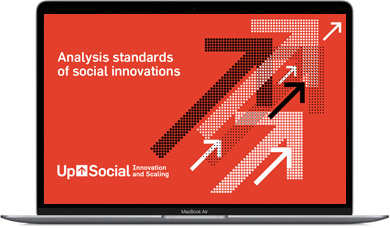People and organisations around the world are constantly experimenting with new approaches and interventions aimed at contributing to solve social challenges. Instead of starting from scratch, we believe on systematically identify who is trying to tackle the same problem somewhere else, analyse their outcomes, the strength of the evidence that supports them and the theory of change. We have found this extremely powerful when it is driven by demand, by the need to find more effective responses to social problems.
UpSocial uses these standards of analysis to evaluate the potential impact of an innovation on a different context, offering decision makers and key stakeholders this tool for better understanding innovations.

This document draws from numerous research and standards developed by other organisations. We actually consider this to be a living document that claims to be regularly reviewed both to define the essential dimensions of analysis and the levels within each dimension. By documenting and openly sharing this document, we invite readers to develop and improve it.
Standards: five dimensions of a social innovation
- Strength of the evidence
-
This standard analyses the strength of the evidence supporting outcomes of an innovation, based on the objectivity of the measurement process and reports supporting the attribution and correlation of outcomes to the activity.
- Proven evidence. A positive impact has been attributed to the innovation through experimental or quasi-experimental control tests.
- Strong evidence. Social outcomes have been documented by external studies, strong internal monitoring tools (such as follow-up online platforms and longitudinal statistic studies) or other objectifiable data (contracts, academic results, etc.).
- Promising evidence. The organisation has documented the intervention’s results by means of evaluations or satisfaction surveys which provide indicators that point out a correlation with a positive change.
- Documented theory of change. Although no evaluations have been conducted, the intervention is based on a consolidated and documented theory of change that foresees positive changes.
- Promising theory of change. There is at least one logical reason that makes the impact of the intervention predictable. External recognitions can support the theory of change.
- Innovation type
-
This standard allows to analyse what kind of innovation is generated according to the scope of action from which the initiative is being introduced (formal or informal) and the type of change generated in the system (sustaining or disruptive).
- Improving. The innovation is generated within the formal field. It suggests improvements or develops existing answers without questioning their original approach.
- Supplementing. The innovation effectively responds to the challenge involving external actors, usually within the community. It contributes with strategies that add up when achieving a bigger impact in the key aspects of the problem.
- Reinventing. The change is introduced within the formal system, but it formulates a totally new approach and forces to rethink existing responses, such as providing different roles to traditional agents or incorporating new ones.
- Transforming.The is generated outside the traditional system, offering totally new responses that represent alternatives to the existing ones.
- Adaptation experience
-
This standard analyses the degree of experience in taking the innovation to different contexts. It looks at its trajectory and success in adapting the activity to different local contexts and generating similar outcomes.
- Proven interregional adaptation. The model delivers social outcomes in two or more sociocultural contexts which are different from the original one, thus proving the model’s adaptability.
- Isolated interregional adaptation. The model model works in a sociocultural context which is different from the original one, thus pointing out an international scale potential.
- Regional adaptation. The model works outside the original context either in a regional level or in a network of locations.
- Local adaptation. The model works outside the original context, in a punctual local field.
- Isolated experience. The innovation works successfully in a particular local context and there is no information on whether it is context-specific.
- Transfer model
-
This dimension analyses how the innovations has structured its knowledge and information, how well-documented it is to ensure adoption and adaptation with fidelity.
- Scalable. The innovation is thoroughly documented and it has a mature, clear and flexible transfer model, which includes systematised accompaniment.
- Consolidated. The innovation is thoroughly documented and has a clear and flexible transference model, which includes non-systematised accompaniment.
- Structured. The innovation is partially documented and has at least one transference model, which has been applied in a punctual way or in similar contexts.
- Incipient. The innovation is partially documented, but it lacks a developed transference model.
- Explorable. The innovation is translatable to other contexts, although it is not documented nor has it a developed transference model.
- Income-generating model
-
The income-generating model enables to capture part of the initiative’s value to ensure sustainability and potential scalability. What is important, however, is that the initiative can generate enough income to achieve social outcomes in a continuous and scalable way.
- Scalable. The conditions that allow its sustainability at scale are found in various other sociocultural and/or economic contexts.
- Adapted. The conditions that allow its sustainability at scale are found in at least a different sociocultural and/or economic context.
- Adaptable. The income model works in contexts which are similar to the one it was originally implemented on. In addition, it offers the possibility of adapting it to different sociocultural and/or economic contexts.
- Established in origin. Its sustainability conditions have been checked in a particular context.
- Experimental. The project has at least one funding source, which makes it currently feasible.

